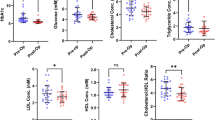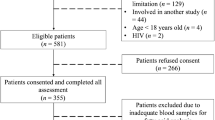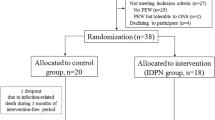Abstract
Background/Objective:
Subjects suffering from lipoprotein lipase (LPL) deficiency show very severe hypertriglyceridemia, often accompanied by recurrent bouts of pancreatitis. Dietary intervention is currently considered first-line treatment of this condition in paediatric age. The aim of our study was to compare the effects of dietary treatment with a low-fat diet alone and a low-fat diet enriched with omega-3-fatty acids.
Subjects/Methods:
The data of 11 patients with LPL deficiency who were diagnosed in our lipid clinic between October 1997 and October 2007 were summarised. All patients had been treated with a low-fat diet, and in addition a group of five patients received supplements of omega-3-fatty acids over a period of at least 5 months.
Results:
After adjustment for pre-intervention TG concentration, there was a statistically significant difference in post-intervention TG concentrations between the interventions, F(1,8)=13.529, P=0.006, partial η2=0.628. Post-intervention-adjusted TG concentrations were statistically significantly greater in the low-fat diet group vs the w3 diet group (P <0.05).
Conclusions:
We provide first evidence that a low-fat diet supplemented with omega-3-fatty acids results in a pronounced decrease in TG in paediatric patients affected with LPL deficiency. However, further studies are necessary to evaluate the long-term effects and safety of omega-3-fatty acids.
This is a preview of subscription content, access via your institution
Access options
Subscribe to this journal
Receive 12 print issues and online access
$259.00 per year
only $21.58 per issue
Buy this article
- Purchase on Springer Link
- Instant access to full article PDF
Prices may be subject to local taxes which are calculated during checkout
Similar content being viewed by others
References
Brunzell JD, Iverius PH, Scheibel MS, Fujimoto WY, Hayden MR, McLeod R et al. Primary lipoprotein lipase deficiency. Adv Exp Med Biol 1986; 201: 227–239.
Ebara T, Endo Y, Yoshiike S, Tsuji M, Taguchi S, Murase T et al. A 60-y-old chylomicronemia patient homozygous for missense mutation (G188E) in the lipoprotein lipase gene showed no accelerated atherosclerosis. Clin Chim Acta 2007; 386: 100–104.
Kawashiri MA, Higashikata T, Mizuno M, Takata M, Katsuda S, Miwa K et al. Long-term course of lipoprotein lipase (LPL) deficiency due to homozygous LPL(Arita) in a patient with recurrent pancreatitis, retained glucose tolerance, and atherosclerosis. J Clin Endocrinol Metab 2005; 90: 6541–6544.
Zhang X, Qi R, Xian X, Yang F, Blackstein M, Deng X et al. Spontaneous atherosclerosis in aged lipoprotein lipase-deficient mice with severe hypertriglyceridemia on a normal chow diet. Circ Res 2008; 102: 250–256.
Holzl B, Kraft HG, Wiebusch H, Sandhofer A, Patsch J, Sandhofer F et al. Two novel mutations in the lipoprotein lipase gene in a family with marked hypertriglyceridemia in heterozygous carriers. Potential interaction with the polymorphic marker D1S104 on chromosome 1q21-q23. J Lipid Res 2000; 41: 734–741.
Kasai M, Maki H, Nosaka N, Aoyama T, Ooyama K, Uto H et al. Effect of medium-chain triglycerides on the postprandial triglyceride concentration in healthy men. Biosci Biotechnol Biochem 2003; 67: 46–53.
Swift LL, Hill JO, Peters JC, Greene HL . Medium-chain fatty acids: evidence for incorporation into chylomicron triglycerides in humans. Am J Clin Nutr 1990; 52: 834–836.
Calabrese C, Myer S, Munson S, Turet P, Birdsall TC . A cross-over study of the effect of a single oral feeding of medium chain triglyceride oil vs. canola oil on post-ingestion plasma triglyceride levels in healthy men. Altern Med Rev 1999; 4: 23–28.
Asakura L, Lottenberg AM, Neves MQ, Nunes VS, Rocha JC, Passarelli M et al. Dietary medium-chain triacylglycerol prevents the postprandial rise of plasma triacylglycerols but induces hypercholesterolemia in primary hypertriglyceridemic subjects. Am J Clin Nutr 2000; 71: 701–705.
Rouis M, Dugi KA, Previato L, Patterson AP, Brunzell JD, Brewer HB et al. Therapeutic response to medium-chain triglycerides and omega-3 fatty acids in a patient with the familial chylomicronemia syndrome. Arterioscler Thromb Vasc Biol 1997; 17: 1400–1406.
Illingworth DR, Connor WE, Miller RG . Abetalipoproteinemia. Report of two cases and review of therapy. Arch Neurol 1980; 37: 659–662.
Partin JS, Partin JC, Schubert WK, McAdams AJ . Liver ultrastructure in abetalipoproteinemia: Evolution of micronodular cirrhosis. Gastroenterology 1974; 67: 107–118.
Park Y, Harris WS . Omega-3 fatty acid supplementation accelerates chylomicron triglyceride clearance. J Lipid Res 2003; 44: 455–463.
Nestel PJ, Connor WE, Reardon MF, Connor S, Wong S, Boston R . Suppression by diets rich in fish oil of very low density lipoprotein production in man. J Clin Invest 1984; 74: 82–89.
Pschierer V, Richter WO, Schwandt P . Primary chylomicronemia in patients with severe familial hypertriglyceridemia responds to long-term treatment with (n-3) fatty acids. J Nutr 1995; 125: 1490–1494.
Richter WO, Jacob BG, Ritter MM, Schwandt P . Treatment of primary chylomicronemia due to familial hypertriglyceridemia by omega-3 fatty acids. Metabolism 1992; 41: 1100–1105.
Pejic RN, Lee DT . Hypertriglyceridemia. J Am Board Fam Med 2006; 19: 310–316.
Scott LJ . Alipogene tiparvovec: a review of its use in adults with familial lipoprotein lipase deficiency. Drugs 2015; 75: 175–182.
Manlhiot C, Larsson P, Gurofsky RC, Smith RW, Fillingham C, Clarizia NA et al. Spectrum and management of hypertriglyceridemia among children in clinical practice. Pediatrics 2009; 123: 458–465.
Boberg J, Augustin J, Baginsky ML, Tejada P, Brown WV . Quantitative determination of hepatic and lipoprotein lipase activities from human postheparin plasma. J Lipid Res 1977; 18: 544–547.
Daniels SR, Greer FR . Lipid screening and cardiovascular health in childhood. Pediatrics 2008; 122: 198–208.
Friedewald WT, Levy RI, Fredrickson DS . Estimation of the concentration of low-density lipoprotein cholesterol in plasma, without use of the preparative ultracentrifuge. Clin Chem 1972; 18: 499–502.
Salakhutdinov NF, Laev SS . Triglyceride-lowering agents. Bioorg Med Chem 2014; 22: 3551–3564.
Chahal N, Manlhiot C, Wong H, McCrindle BW . Effectiveness of Omega-3 polysaturated fatty acids (Fish Oil) supplementation for treating hypertriglyceridemia in children and adolescents. Clin Pediatr (Phila) 2014; 53: 645–651.
Schluter B, Trowitzsch E, Andler W . [Primary hyperlipoproteinemia Type I in the neonatal period]. Klin Padiatr 1990; 202: 355–360.
Shirai K, Kobayashi J, Inadera H, Ohkubo Y, Mori S, Saito Y et al. Type I hyperlipoproteinemia caused by lipoprotein lipase defect in lipid-interface recognition was relieved by administration of medium-chain triglyceride. Metabolism 1992; 41: 1161–1164.
Chou TS, Liu HY, Hsiao PJ, Tseng HI, Chen WY, Lu CC . Hypertriglyceridemia in a 5- day-old newborn—a case report. Kaohsiung J Med Sci 2002; 18: 141–145.
Nagasaka H, Kikuta H, Chiba H, Murano T, Harashima H, Ohtake A et al. Two cases with transient lipoprotein lipase (LPL) activity impairment: evidence for the possible involvement of an LPL inhibitor. Eur J Pediatr 2003; 162: 132–138.
Acknowledgements
We express our sincere gratitude to Maria Fritsch MD for her invaluable help in summarizing the data.
Author information
Authors and Affiliations
Corresponding author
Ethics declarations
Competing interests
The authors declare no conflict of interest.
Rights and permissions
About this article
Cite this article
Helk, O., Schreiber, R. & Widhalm, K. Effects of two therapeutic dietary regimens on primary chylomicronemia in paediatric age: a retrospective data analysis. Eur J Clin Nutr 70, 1127–1131 (2016). https://doi.org/10.1038/ejcn.2016.70
Received:
Revised:
Accepted:
Published:
Issue Date:
DOI: https://doi.org/10.1038/ejcn.2016.70
This article is cited by
-
Familial Chylomicronemia Syndrome (FCS): Recent Data on Diagnosis and Treatment
Current Atherosclerosis Reports (2020)



